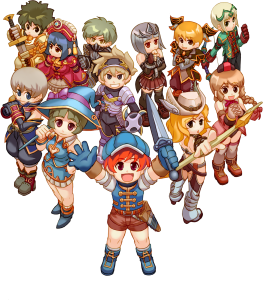Basic 1vs1 SnS Knight Guide
Table of Contents
Introduction
You’ve decided to become a 1vs1 Knight, and in this guide, we’ll help you understand the best weapons, gear sets, accessories, pets, and sockets you’ll need. Our goal is to answer all your questions and provide a clear path forward.
This guide is mostly for a SnS Knight (Sword and Shield), nevertheless we uses mostly Axes in this guide.
Before we dive in, it’s important to note that this guide is tailored specifically for free-to-play players. This means we’re assuming you won’t be using consumables, and you don’t have a high-level character supporting you. We’re working with basic buffs and minimal gear, like +5 enhancements, to ensure that everyone can benefit from this guide, regardless of their resources. Of course, you can always go for better gear, but we’ll stick to the standard setup for simplicity.
Also, this guide assumes that you’re already at least a Level 60 Mercenary. If you’re not there yet and need help leveling up, check out my Mercenary guides—both for AoE and 1v1 playstyles. These will give you tips and tricks to get to Level 60 efficiently.
If you need help with the Mercenary class, we have the 1vs1 Mercenary guide to assist you.
Stat Points “H”
Let’s start with your stat points. We strongly recommend going full STR for your 1v1 Knight.
Knights generally don’t struggle with attack speed, especially when built as we’ll suggest, so you don’t need to invest in DEX. Full STR will maximize your damage output, which is crucial for 1vs1 combat.
Skill Points “K”
Managing skill points as a Knight can be tricky and might surprise some players. Skills play a significant role in your effectiveness, and we highly recommend considering a reskill at Level 60 if you find yourself short on skill points or if you’ve invested in skills that are no longer useful. For instance, any skills you’ve taken as a Mercenary may not be necessary after Level 60, allowing you to focus on more relevant Knight buffs.
Important Skills to Maximize
- Empower Weapon: Always keep this maxed as it boosts your weapon’s damage.
- Weapon-specific Skills: Depending on whether you’re using swords or axes, focus on maxing the corresponding skills (e.g., Sword Mastery or Axe Mastery).
If you still have skill points left from your Mercenary days, you can consider investing in Protection if you’re using a shield, but it’s not crucial. This skill boosts your defense but doesn’t contribute to your damage output, so prioritize other skills first.
Knight Skills
Now let’s move on to the Knight skill tree. Although Knights have many cool skills, not all are relevant for a 1vs1 build. Here are the key skills you should focus on:
- Heart of Fury: This skill is crucial if you’re using a sword and shield. It boosts your damage, attack speed by 10%, and Critical Chance by 10%, making it very powerful.
- Due to this skill, many players prefer to play as a sword-and-shield Knight at Level 60, as the boost from Heart of Fury compensates for any shortcomings in attack speed that two-handed weapons might have.
- Rage: (Attack +15%, you get +10% incoming damage, block penetration+20%.) This is a powerful buff that increases your attack power while decreasing your defense. It’s essential to max out this skill. However, be cautious when using it in tough situations like fighting Giants, where the defense penalty might make you more vulnerable.
- Pain Reflection (Optional): (damage Reflection +75%). While not crucial for 1vs1, this skill can be helpful in reducing the damage you take in prolonged battles, like against Giants. It reflects a portion of the damage back to your attacker, though it only lasts for 5 minutes.
- Pain Dealer (Debuff): This skill is useful in party settings and boss fights. It works with two-handed weapons only and increases the damage your entire party deals to the target by reducing the target’s defense by 20%. This debuff can significantly boost your party’s overall damage output. But all members get 5% more damage.
Situational Skills:
- Guard: This skill reduces the damage you take by 40% at the cost of lowering your own damage output by 25%. It’s more of a tank skill and isn’t typically used in 1vs1 scenarios, but it can be useful in boss fights where survival is more important than dealing damage.
Cloak
When it comes to the cloak, the best choice for a full STR Knight is the Cloak of Strength. This cloak provides an additional +8 STR, which is perfect for maximizing your damage output in a 1vs1 scenario. While there are other options out there, focusing on STR will ensure you’re getting the most out of your build.
Pet
For pets, your choice will largely depend on your current gear and stats. As a full STR Knight, you may find that your Critical Chance is lacking, especially at lower levels. In most cases, a Critical Chance Pet (Angel Cage) is the best option, as it will help offset this deficiency. Critical Chance pets tend to be more affordable and provide a better cost-to-benefit ratio compared to Critical Damage pets.
However, if you have high-end gear or frequently use consumables a Critical Damage pet (King Crab Cage) might become more beneficial. In general, you’ll be switching between a Critical Chance pet and a Critical Damage pet depending on your gear and the situation. For most standard setups, though, the Critical Chance pet is the go-to choice.
Sockets
Your pet choice should also inform how you socket your gear. For example, if you’re using a Critical Chance pet, you’ll want to socket for Critical Damage (Thorn Card) in your weapon. Conversely, if you’re using a Critical Damage pet, focus on socketing for Critical Rate. The goal is to achieve close to 100% Critical Chance and then maximize your Critical Damage. Avoid doubling up on Critical Chance or Critical Damage in both your pet and sockets unless you’re still far from achieving a decent Critical Chance.
Elemental Upgrades
Typically, Element +1 is sufficient for your weapon, as it offers the best practical benefit without unnecessary expense. For a Knight, especially in a 1vs1 setup, elemental upgrades are less critical due to the Empower Weapon skill, which already provides a significant elemental damage boost. In most cases, Element +1 is all you need. Anything beyond that is purely for aesthetics and doesn’t offer much in terms of practical benefit, making it a potential waste of resources.
Key Assist/Ringmaster Buffs for 1v1 Knight
As a 1v1 Knight, certain buffs from an Assist or Ringmaster are essential:
- Mental Sign: This should be prioritized as it increases the duration and potency of all other buffs. Maxing out Mental Sign provides a significant return on investment.
- Haste: Critical for increasing your attack speed, making it the most important buff after Mental Sign.
- Accuracy: This buff is vital for ensuring you hit your targets, especially at lower levels where your hit rate might struggle. It’s more important than Beef Up in many situations, as missing attacks can drastically reduce your damage output.
After prioritizing these buffs, you can allocate points into others based on your needs:
- Beef Up: If you’re struggling with damage, this buff increases STR, enhancing your overall damage.
- Heap Up: While not as crucial, it provides extra STA and can be useful if you’re having trouble surviving.
Every other buff should be at least at level 1, as any buff is better than none. With the Mental Sign buff, even a level 1 buff will gain additional levels, making it more effective.
Jewelry
For your jewelry, the standard setup at Level 60 includes:
- Two Strente Rings +1: Aim for rings that offer as much STR as possible.
- Two Mighteer Earrings +1: These should increase additional damage (either attack or Critical Damage).
- HP Necklace: This is generally less important and can be neglected if resources are limited.
Your goal with rings and earrings is to maximize STR and damage. Upgrading the HP necklace isn’t as critical since the HP gain is minimal compared to the cost of upgrading. Focus on maximizing STR and damage through your rings and earrings to boost your combat effectiveness.
Upgrades
Let’s discuss set upgrades before diving into the specifics of each set. For upgrading your gear, aiming for +5 is crucial, especially in the lower levels. +5 is a standard milestone that ensures your equipment is up to par. As a rule of thumb, aim for +5 on your gear as you start using sets, with the Comet/Cylos Set being the default choice early on.
For the initial stages, a clean Comet/Clylos Set at level 30 is sufficient, and you don’t need to stress about upgrades right away. Typically, by level 104 or 105, upgrading to +6 with three sockets with 4% Lightning card (Attack) is ideal. If you can manage +6, it is slightly better, but if you only have +5, that’s perfectly fine as well. Once you hit level 105, it’s recommended to upgrade to +8 and aim for 16% Attack. Be cautious about upgrading your equipment yourself, as upgrading to +8 and enhancing four slots can be risky and often not worth the cost, so try to buy it.
Sets
Comet/Cylos Set
Start with the Comet/Cylos Set at level 30. This set provides essential stats like Hit Rate +10%, Critical Chance +7%, and Attack Speed +15%, which are crucial for maximizing your performance in 1v1 battles. These three stats are fundamental to any 1v1 build, and the Comet/Cylos Set helps you achieve close to 100% in these areas.
Higher Sets
At level 90, you can transition to a slightly upgraded version of the Comet/Cylos, which offers improved Critical Chance (+15%) and Hit Rate (+15%) unfortunately loosing 5% Attack Speed. While a switch isn’t strictly necessary, especially if your Comet/Cylos Set is in good condition, it’s generally recommended. The Comet/Cylos Set can become quite vulnerable to damage, so upgrading to the Knighert/Knighz Set (or another appropriate set) is advisable. The Knighert/Knighz Set provides better survivability because of much more def and damage output, making it a more durable option for higher levels.
At level 105, the Ectro/Extro Set becomes available. This set maintains similar stats to the Comet/Cylos Set but replaces Hit Rate with Critical Damage. The key stats for this set are Critical Damage +25%, Attack Speed +20%, and Critical Chance +20%.
Finally, at level 135, the Cryro/Cyrent Set provides a significant upgrade with a total of 35% Critical Chance, Attack Speed +20%, and Critical Damage + 40%. Additionally, it gives +20 STR. This set represents the pinnacle of 1v1 Knight gear.
Manebound/Manetress Set
There is also the Level 150 Manebound/Manetress Set, which offers even greater benefits with +40% Critical Chance, +60% Critical Damage, +30% Attack Speed, and +35 STR. This set is currently very expensive and may remain out of reach for most players for some time. For now, the Cryro/Cyrent Set is highly effective and cost-efficient.
Weapons
Weapons are perhaps the most controversial and interesting aspect for Knights in the game. Knights are unique in that they have a variety of weapon choices, especially when compared to classes like the Blade. Knights can choose from four types of weapons, though not all are available at every level. Some weapons are designated as 1v1 or AoE weapons based on their level.
For example, the Guardian Sword at level 60 is an AoE weapon, while the Guardian Big Axe at the same level is also an AoE weapon, known for its defensive properties. This means that you don’t always have the freedom to choose among all four types of weapons. Instead, you often have two or three viable options, which can still offer a significant variety.
Guardian Axe is highly recommended for level 60 one-hand Knights. It is an effective one-handed weapon, especially when paired with the Ancient Shield. It’s crucial to keep plenty of FP potions on hand to ensure that Heart of Fury remains active, as it consumes FP to increase your damage output. Alternatively, if FP management is a concern, using Vital Drinks X or a Peison Necklace can help mitigate FP costs.
If Guardian Axe is too costly, consider using the Critin Axe for level 57. Although it’s a lower-budget option compared to the Guardian Axe, it provides 7% Critical Chance and can be a good alternative. You can often find Critin Axe in the shop for around one million Penya or drop it yourself if you’re familiar with the game’s mechanics.
Continue using the Guardian Big Axe until level 90. At this point, switch to an Angel Big Axe, which offers 15% Critical Damage and 25% Critical Chance, providing a substantial boost to your damage output. If you prefer to remain a sword-and-shield Knight, you can still use the Angel Axe, but the Angel Big Axe is generally recommended for the best damage.
At level 105, you will need to switch to the Legendary Golden Big Sword, as the Big Axe becomes an AoE weapon. If you wish to continue with a sword-and-shield setup, use the Legendary Golden Sword.
By level 120, you have the choice between the Bloody Slayer and the Bloody Executioner. Both offer strong 1vs1 stats, with the Bloody Executioner generally providing higher damage output. For one-handed weapons, the Bloody Axe is a good option.
Finally, at level 150, the Lusaka’s Heavy Crystal Sword and Lusaka’s Heavy Crystal Axe becomes available. This weapon offers the choice between big swords/axe and one-handed sword/axe. A DPS rankings had shown that the difference between one-handed and two-handed weapons is minimal, typically around 2.5%, so you can choose based on your preference and budget. For two-handed weapons, the Big Axe is generally preferred due to its slightly higher damage output.
In summary, our personal recommendation is to use the Guardian Axe weapon until level 90 and then switch to the two-hand weapon like Angel Big Axe for the highest damage output. If you prefer a sword-and-shield setup, the Angel Sword is a good choice.
Shields
Shields are often considered the least important aspect for 1vs1 Knights, as they generally have minimal impact on damage output. For a sword-and-shield setup, the Ancient Shield (all stats +4) is typically used. The Iblis Shield is usually not worth the cost, as it only offers one additional stat and minimal defensive benefit. You should take the Azure Shield (all stats +7).
At higher levels, if you continue with a sword-and-shield build, you can use the Coral Shield, although it is relatively expensive and only provides three additional stats (compared to the Azure Shield). The Lusaka’s Crystal Shield (All stats +10, Critical Chance, and Critical Damage +5%) is the ultimate option but is extremely costly.
In general, it’s advisable to choose shields based on your budget. If you can afford the Coral Shield, it’s a good choice. Otherwise, the Azure Shield offers a more affordable alternative with comparable performance. Shield upgrades generally do not significantly impact your damage output; they mainly provide defensive benefits, such as block rate.
Source: The Guide was originally explained by Spielestyler in his YouTube video in German.









